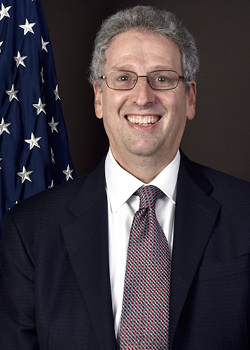This piece was originally published in the January/February 2019 issue of electroindustry.
 Richard Glick, Commissioner, Federal Energy Regulatory Commission (FERC)
Richard Glick, Commissioner, Federal Energy Regulatory Commission (FERC)
The Intergovernmental Panel on Climate Change (IPCC) recently concluded that we are on track to see global temperatures rise by 1.5°C as early as 2030. The Trump Administration’s most recent National Climate Assessment also indicates that, absent a dramatic reduction in greenhouse gas emissions, the annual economic consequences of climate change will reach into the hundreds of billions of dollars by the end of the century.
Until recently, the electricity sector had been the largest source of greenhouse gas emissions in the United States. A combination of improved energy efficiency and significant reductions in the cost of renewable and natural-gas generation has caused electricity-sector emissions to decline by 28 percent since 2005. But much more needs to be done. According to the IPCC, carbon dioxide emissions must be reduced by at least 45 percent from 2010 levels over the next 12 years. Avoiding the worst effects of climate change will likely require the electrification of other parts of the economy, especially the transportation sector, which is now the nation’s principal source of greenhouse gas emissions.
Despite these daunting challenges, we have the technology to reduce greenhouse gas emissions. Wind and solar generation continue to grow at exponential rates, producing as much as 60 to 70 percent of all electricity consumed in markets as diverse as California and the Southwest Power Pool.
Repeating the mindless mantra that “the sun doesn’t shine and the wind doesn’t blow all the time” ignores that we possess technologies that address the variability of renewable energy resources. For instance, operational protocols and greater regional coordination can smooth out the ebbs and flows of variable generation technologies, just as they accommodate fluctuations in demand. Energy storage technologies like batteries, pumped hydro, and compressed air can enhance the flexibility of the grid and reduce the cost of electricity at peak periods.
We cannot, however, achieve a decarbonized electric generation sector without a robust grid. Although the U.S. has some of the best renewable resources, they are often situated in remote locations. Accessing them will require a significant investment in long-haul transmission facilities. Developing interregional transmission infrastructure has the potential to deliver billions of dollars in savings to consumers by reducing congestion and unleashing new renewable projects trapped in interconnection queues across the country. For example, the Eastern Interconnection States Planning Council recently found that increasing interregional and other proactive planning could provide $90 billion in system-wide savings for consumers.
A stronger grid is also necessary for distributed energy resources (DERs) to achieve their potential. While DERs represent only two percent of installed capacity, consumer demand and state targets are transforming how we build and consume power, resulting in a tremendous increase in their installation.
In 2016, more than 12 percent of all new generating capacity in the U.S. came from distributed photovoltaic solar. Nowhere is this more evident than in California, which is well on its way toward procuring 12,000 MW of distributed renewable resources by 2020. Integrating these new DERs reliably and efficiently will require the development of a more modern, nimble grid that can handle the substantial growth in two-way transactions that DERs and energy storage will facilitate.
Although FERC is not an environmental regulator, our actions affect the country’s ability to achieve meaningful greenhouse gas emissions reductions. It must continue to remove barriers to new technologies and ensure that these resources can compete on a level playing field. Similarly, FERC must facilitate the development of a robust and resilient grid that is capable of integrating the expected growth in renewable and distributed resources.